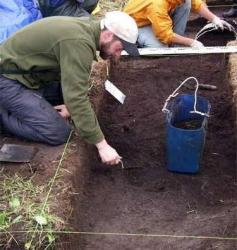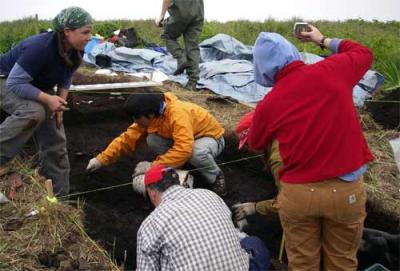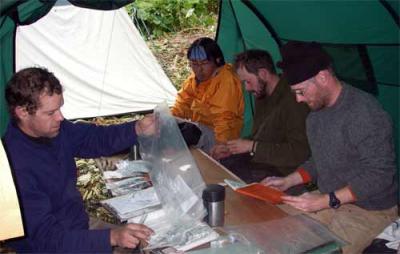So far, so good – the weather appears to be holding out well! We have had no sign of the stormy weather indicated by the Iskatel…
Today we spent our first full day working at the site. Right after breakfast, we got packed our day packs with whatever gear we thought that we might need – rain pants and jackets, extra layers, bug spray, sunscreen, warm hats and gloves …. Oh yeah! And the archaeological equipment, too! We needed to bring lots of sample bags, our trowels and the screens.
As we excavate, we look for "obvious” artifacts by scraping away small amounts of dirt with a trowel. Each type of artifact is collected in separate bags by level and unit – faunal material (bones and shells), lithics (flakes of stone that are created when tools are made or the actual tools) and ceramics (broken bits of pottery).
**Matt Walsh excavating Unit 1 **
 Matt Walsh works on excavating Level 2 of Unit 1 at the Vodapadnaya excavation site.
He is carefully scraping away a thin layer of dirt with his trowel and looking for any
artifacts that might be present. The dirt that he is removing – called back dirt – will
be screened to be sure that he doesn’t miss anything big.
Matt Walsh works on excavating Level 2 of Unit 1 at the Vodapadnaya excavation site.
He is carefully scraping away a thin layer of dirt with his trowel and looking for any
artifacts that might be present. The dirt that he is removing – called back dirt – will
be screened to be sure that he doesn’t miss anything big.
It was initially decided that we would dry screen three of every four buckets of back dirt that were removed with the 1/4-inch mesh screens and wet screen the fourth bucket in the 1/8-inch mesh screens. Screening is done to find the smallest bits of flake and bones and anything that might have been missed in the initial excavation with a trowel.
When doing this sort of sampling, we know that we are not getting EVERY artifact, that we will naturally miss some of the smaller things in the dirt. But what is more important is that we are getting a consistent sampling of what is in the excavation site. This gives the kind of data that the scientists want to have in order to better understand what the people that were living here were doing. They are more interested in a larger representative sample to compare between sites and time periods, rather than an exhaustively complete cataloging of what is at one specific site. This is also why we are trying to dig in middens and not in house pits. Excavating a house pit will tell us how ONE family lived in ONE specific place over ONE specific time period. To answer the questions for this project, we want to know more about each of the different occupational periods for each of the different cultures over a larger area of the islands.
In order to wet screen we used a small gasoline-powered pump to push water from the stream through a hose up to the top of the terrace where we were working. Then we used the water to wash the dirt off the material that was in the screen. Then we sorted through what was left on the screen – small rocks, bits of charcoal, and roots from plants as well as the artifacts – and pulled out the faunal material, lithic flakes and any ceramics. These were put in their own separate bags by unit and level.
For the morning, Mike Etnier and I worked on wet screening, while the rest of the group worked on excavating. Around lunchtime, Ben decided that, in order to get more of the excavation done within the six days that we have left to work here, that we should stop the 1/4-inch dry screening for now (at least until we get to levels with more artifacts) and only do the 1/8-inch wet screening of every fourth bucket. This means that we would not recover as much material, but will get a larger overall sample for the complete time period if we can move a little more quickly to get to the "bottom” of the excavation.
In the afternoon, Mike and I traded with Matt and Colby and worked on excavating Unit 1. While we are using the trowels, if we come across an artifact that is more than merely a flake – such as a projectile point or worked bone or wood – then we mark its specific location within the unit in three dimensions. To do this you measure along the edges of your unit to find its location on an imaginary grid. Then you use a line level, string and a tape measure to measure its depth from a specific point, called the secondary datum point. We use a stake that is just to the south of the excavation site, whose location relative to the master datum point has been measured precisely with the surveyor’s level and stadium rod. That way all of the artifact depths are measured consistently. Each of these artifacts is then separately bagged, labeled and marked on the excavation unit-level forms.
Measuring the Location of an Artifact
 Shelby Anderson and Dani Plante work with a line level and string to measure the depth of an artifact from Level 2 of Unit 3 at the Vodapadnaya excavation site. For consistency, the string is attached to a stake that is used to measure the depths of all of the artifacts and whose location relative to the master datum point has been marked with the surveyor’s level and stadium rod. Taku Osaka, Volodya Gulobtsov and Natasha Toropova are working in the excavation.
Shelby Anderson and Dani Plante work with a line level and string to measure the depth of an artifact from Level 2 of Unit 3 at the Vodapadnaya excavation site. For consistency, the string is attached to a stake that is used to measure the depths of all of the artifacts and whose location relative to the master datum point has been marked with the surveyor’s level and stadium rod. Taku Osaka, Volodya Gulobtsov and Natasha Toropova are working in the excavation.
At the end of the working day, we had not gotten to the bottom of Level 2 in all of the Units. We were working on trying to connect the bottom of Level 2, which appears to be another brownish cinder layer, between the Units when it was time to come down for dinner. So we left the unraveling of that puzzle until tomorrow morning!
After dinner, the crew worked to finish the cataloging and processing of the samples that we had taken today. Namely, checking that the bag labels are complete – with the date, site, unit and level, the type of sample/artifact, a unique identification number from the artifact catalog and the initials of the people working in that unit when it was found. All of that information is double-checked with the artifact catalog to be sure that it is the same and then another metal tag with just the ID number is placed inside the bag in case any of the information on the outside wears off or is unreadable. That way the origin of all of the samples can, hopefully, always be determined.
**Working in the "Laboratory” Tent **
 Mike Etnier, Taku Osaka, Matt Walsh and Colby Phillips work in the "laboratory" tent
to catalog and process artifact samples from the first day of excavating at Vodapadnaya.
Mike Etnier, Taku Osaka, Matt Walsh and Colby Phillips work in the "laboratory" tent
to catalog and process artifact samples from the first day of excavating at Vodapadnaya.
Well, here is hoping that our weather continues to hold!
Spokonye Noche! Misty

